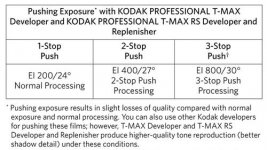znapper
Well-known
Let me try and simplify it. Exposing it at 200 gives a one stop underexposed negative. With most films, increasing the developing time 20% or so will give a slight increase in shadow detail, helping to alleviate the lowered quality that results from underexposure. TMX doesn't push well, meaning that you won't gain any useful shadow density with a longer developing time. If you must underexpose it, you're best developing it normally and then trying to compensate for it in the printing or scanning stage.
I want to emphasize that shooting TMX at 200 REDUCES image quality. You will get the best results with TMX, as with any film by exposing it at the correct EI for the developer you're using. Shooting at 200 should be considered an emergency technique, not something you do normally.
.
Again, I understand what you are saying, I have no issue with that.
The issue I have with this, is that Kodak would be hard-pressed to just state "develop normally" if there is degradation, more grain and/or loss of shadow detail.
Such facts should be in the datasheet, which is isn't really.
They publish the same dev-times for EI 100 and EI 200, as if it doesn't matter and, leaving push-processing and it's effects out of this for a moment, it seems they claim it can be shot at either EI with no particular loss of quality or shadow detail.
I know the effects of both pushing and pulling, but Kodak state that you don't have to push-process the film at 200 for some reason and nobody seems to know why that is.
As per this answer in a discussion over at APUG a while back:
http://www.apug.org/forum/index.php...ompared-to-tmax400.141020/page-2#post-1845015
and this
http://www.apug.org/forum/index.php?threads/interesting-observation-with-tmax-100.30170/
But, from what I've red around the interwebs, it seems that Tmax 400 @ 200, with pull-processing, is the better option, especially when you are looking for the best tonal range and shadow detail, Tmax 400 can handle being shot at 200 with ease.


